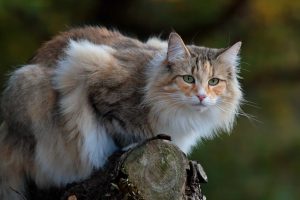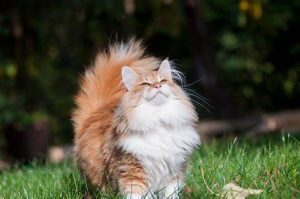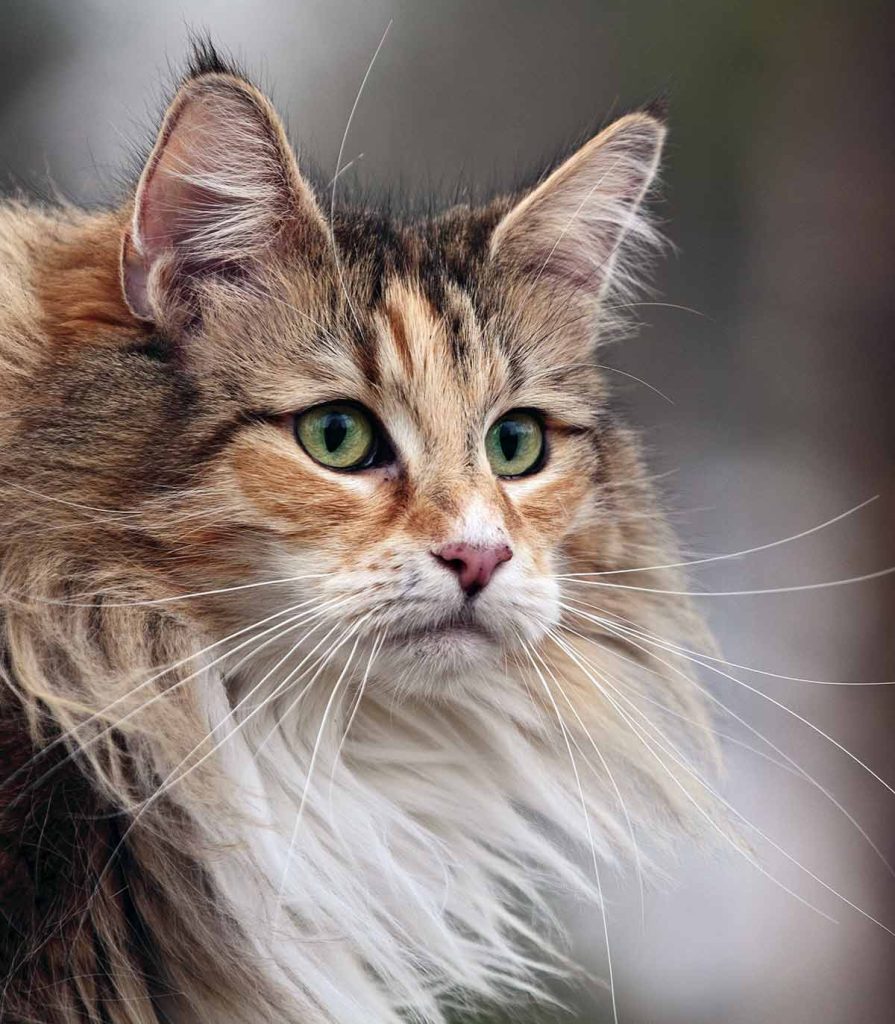Basic information about Norwegian Forest Cats
The Norwegian Forest Cat is a majestic and rugged breed known for its thick, water-repellent coat, tufted ears, bushy tail, and robust build. Here’s an overview of the Norwegian Forest Cat:
Appearance
The Norwegian Forest Cat is a large and muscular breed with a sturdy and well-proportioned body. They have a rectangular shape, with a broad chest, strong legs, and a long, flowing tail that tapers to a bushy tip.
Their head is triangular in shape, with a straight profile, and they have large, almond-shaped eyes that come in various colors, including green, gold, or copper. Their ears are tufted and may have lynx-like tufts of hair on the tips.
The most distinctive feature of the Norwegian Forest Cat is its dense, double-layered coat, which consists of a water-resistant outer coat and a thick, woolly undercoat. The coat is long and flowing, particularly around the neck (ruff), chest, and tail. It comes in a variety of colors and patterns, including tabby, solid, and tortoiseshell.

Temperament
Norwegian Forest Cats are known for their gentle, friendly, and laid-back temperament. They are sociable cats that enjoy the company of their human companions and get along well with children, other pets, and strangers.
Despite their large size and rugged appearance, Norwegian Forest Cats are affectionate and affectionate cats that form strong bonds with their owners. They are often described as “gentle giants” due to their calm and patient demeanor.
Norwegian Forest Cats are intelligent and independent cats that enjoy exploring their surroundings and engaging in activities that challenge their minds and bodies. They are skilled climbers and may enjoy perching on high vantage points to survey their territory.
History
The Norwegian Forest Cat is an ancient breed that has existed in Norway for centuries. They are believed to have evolved naturally in the forests of Norway, where they developed thick, water-repellent coats to withstand the harsh Nordic climate.
Norwegian Forest Cats were revered as skilled hunters and valued companions by the Vikings, who brought them on their ships to control rodent populations. They were also celebrated in Norse mythology as magical forest creatures known as “skogkatt” or “fairy cats.”
The Norwegian Forest Cat breed faced near-extinction in the mid-20th century due to crossbreeding with other cat breeds and habitat loss. However, dedicated efforts by Norwegian breeders helped to preserve and promote the breed, leading to its recognition by major cat associations worldwide.
Health
The Norwegian Forest Cat is generally a healthy and robust breed with few genetic health problems. However, like all cat breeds, they may be prone to certain health issues. Here are some health considerations for Norwegian Forest Cats:
- Hypertrophic Cardiomyopathy (HCM): HCM is a common heart condition in cats, including Norwegian Forest Cats. It causes the heart muscle to thicken, leading to inefficient pumping of blood. Regular veterinary check-ups, including cardiac screenings, can help detect and manage HCM early.
- Hip Dysplasia: While not as common as in some other breeds, hip dysplasia can occur in Norwegian Forest Cats. This condition involves abnormal development of the hip joint, leading to discomfort and mobility issues. Responsible breeding practices and regular veterinary care can help manage hip dysplasia.
- Gastrointestinal Issues: Some Norwegian Forest Cats may be prone to gastrointestinal issues such as inflammatory bowel disease (IBD) or food sensitivities. Maintaining a balanced diet, providing regular exercise, and monitoring your cat’s digestive health can help prevent and manage these conditions.
- Dental Problems: Dental issues such as periodontal disease can affect Norwegian Forest Cats, especially as they age.
- Obesity: Norwegian Forest Cats are large and muscular cats, but they may still be prone to obesity if overfed or not provided with enough exercise. Monitoring your cat’s weight, providing a balanced diet, and engaging in regular play and exercise can help prevent obesity-related health problems.
Care
Norwegian Forest Cats have a dense, double-layered coat that requires regular grooming to prevent mats and tangles. Brushing two to three times a week helps to remove loose hair and distribute natural oils, keeping the coat healthy and shiny.
Provide a balanced and nutritious diet appropriate for your Norwegian Forest Cat’s age, weight, and activity level. Ensure access to fresh water at all times, and monitor their food intake to prevent obesity.
Keep your Norwegian Forest Cat mentally and physically stimulated with interactive toys, puzzle feeders, and play sessions. They enjoy climbing, exploring, and engaging in activities that mimic their natural hunting instincts.
Schedule regular veterinary check-ups to monitor your Norwegian Forest Cat’s health and address any potential issues early on. Keep up with vaccinations, parasite prevention, dental care, and routine blood work as recommended by your veterinarian.

Overall, the Norwegian Forest Cat is a beloved and cherished breed known for its majestic appearance, gentle temperament, and fascinating history. They make excellent pets for individuals and families alike, bringing warmth, companionship, and joy to their homes for many years.
More posts you might be interested in:

